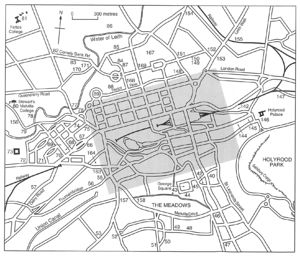Building stones in Edinburgh from the Carboniferous of Fife
From: McMillan, A.A., Gillanders, R.J. and Fairhurst, J.A. 1999 Building stones of Edinburgh. Edinburgh: Edinburgh Geological Society.


Fife sandstone from Longannet, Cullalo, Grange and Fordell was shipped across the Forth to Leith. More quarries were brought into use by the Edinburgh builders exploiting the new railways and transport was made easier with the opening of the Forth Bridge in 1890.
Much of the sandstone from Fife used in Edinburgh comes from the Grange Sandstone in the West Lothian Oil-Shale Formation. It has been worked principally at Grange, Newbigging and Dalachy quarries near Burntisland. Cullalo quarries may have worked this or a sandstone higher in the sequence. At Fordell, the quarry referred to as Millstonemeadow by Watson (1911) is in strata of the Lower Limestone Formation.
Grange
At Grange Quarry the sandstone is at least 36 m thick of which the basal 21m has been described as an excellent liver rock. Above this are 8m of sandstone beds which are only suitable for rubble work. It has been described as a 'very pure greyish white sandstone' which hardens on exposure. Gowans stated that it was used particularly in Leith from 1870 onwards. Examples of stone from Grange Quarry include:
Victoria Primary School (1875-1896), Newhaven Main Street.
Old College, University of Edinburgh, dome (28) (1887), South Bridge.
Seafield Lodge, Seafield Cemetery (1889), Seafield Place.
Bonnington Primary School (1875), Bonnington Road.
Newbigging
Newbigging Quarry previously exposed about 37 m of strata. The bottom part of the sandstone is limy and passes down into hard limy siltstones and sandstones which rest on 5m of the Burdiehouse Limestone. The latter has also been quarried and mined at this locality. In 1870, the quarry provided stone for the building of the Gustavi Cathedral in Gothenburg and was reopened by Scottish Natural Stones Ltd. in 1979 to provide stone for the repairs. The quarry was again reopened on 11 June 1984 to provide stone for the National Library of Scotland extension when only the bottom bed of the quarry was worked; the top beds were discarded as being not to specification.
The stone has been used at the new National Library of Scotland Causewayside building (47) (1984-87) & Phase II (completed 1994). The stone here is a very striking cross-bedded, light creamy brown, medium-grained sandstone with brown ferruginous spots. It has an attractive marbled appearance due to the presence of blotches of limonite. The stone is soft when quarried but is said to harden when exposed to the air. This is a stone without a proven reputation as it has not stood long enough to have its weathering qualities tested. However, in Burntisland, it has been used since the 1850s and is said to have weathered well.
Cullalo
The yellowish grey sandstone of the Cullalo quarries has been more widely used than the sandstone quarried at Grange or Newbigging. There were two main quarries and several smaller workings at Cullalo. The quarries had long lain abandoned until they were re-opened by Bryce in about 1864 for the building of Fettes College (81) (1864-70). In the early 19th century Cullalo stone had a high reputation though it was not as hard as the stone from Craigleith. It could be dressed easily when fresh but soon hardened on exposure. Gowans (1881) considered the stone to be durable, but owing to the expense of quarrying and difficulty of dressing, it had not continued in use.
The greater part of the High Kirk of St Giles (18), apart from the medieval tower and 19th century additions, were encased between 1829 and 1833 with Cullalo stone. The sandstone which is mostly polished or lightly tooled, is greyish, fine-grained and slightly micaceous. The stone has been laid with the bedding mostly horizontal. Some stones exhibit cross-bedding. There is little evidence of weathering although some ironstone concretions are weathering out. At the foot of the Mound, recently cleaned Cullalo stone can be seen in the northern part of the western colonnade of the Royal Scottish Academy (1822-26) (4). Here, comparisons may be made with Craigleith Sandstone which has a wispy appearance in some blocks and also with the slightly darker Binny Sandstone from Humbie and Binny quarries in West Lothian which are used for the rest of the colonnade. Other buildings which have used stone from the Cullalo quarries include:
Melville Pillar (117) (1820-23) St Andrew Square.
St Mary's Cathedral (69) (1874-1917), Palmerston Place.
Chapel of the Knights of the Thistle, St Giles Cathedral (18) (1909-11), High Street.
Lady Glenorchy's Church (182) (1908-10 & 1912-13), Roxburgh Place. Elsie Inglis Nursing Home (147) (1923), Spring Gardens.
George Watson's College War Memorial (1920), Colinton Road.
Clunevar
Clunevar Quarry, west of Dunfermline, yielded sandstone from the Limestone Coal Formation. The building stone was described by Craig as a soft white sandstone. It has been used in the building of the following tenements:
38 Marchmont Crescent (50) (1881).
Roseburn Terrace tenements (1882).
North Junction Street (1891).
Fordell
This quarry was situated near Aberdour and according to Craig, the stone was white when delivered but turned black in about a year. It was used in the building of Old Granton Parish Church (1877).
| At all times follow: The Scottish Access Codeand Code of conduct for geological field work |